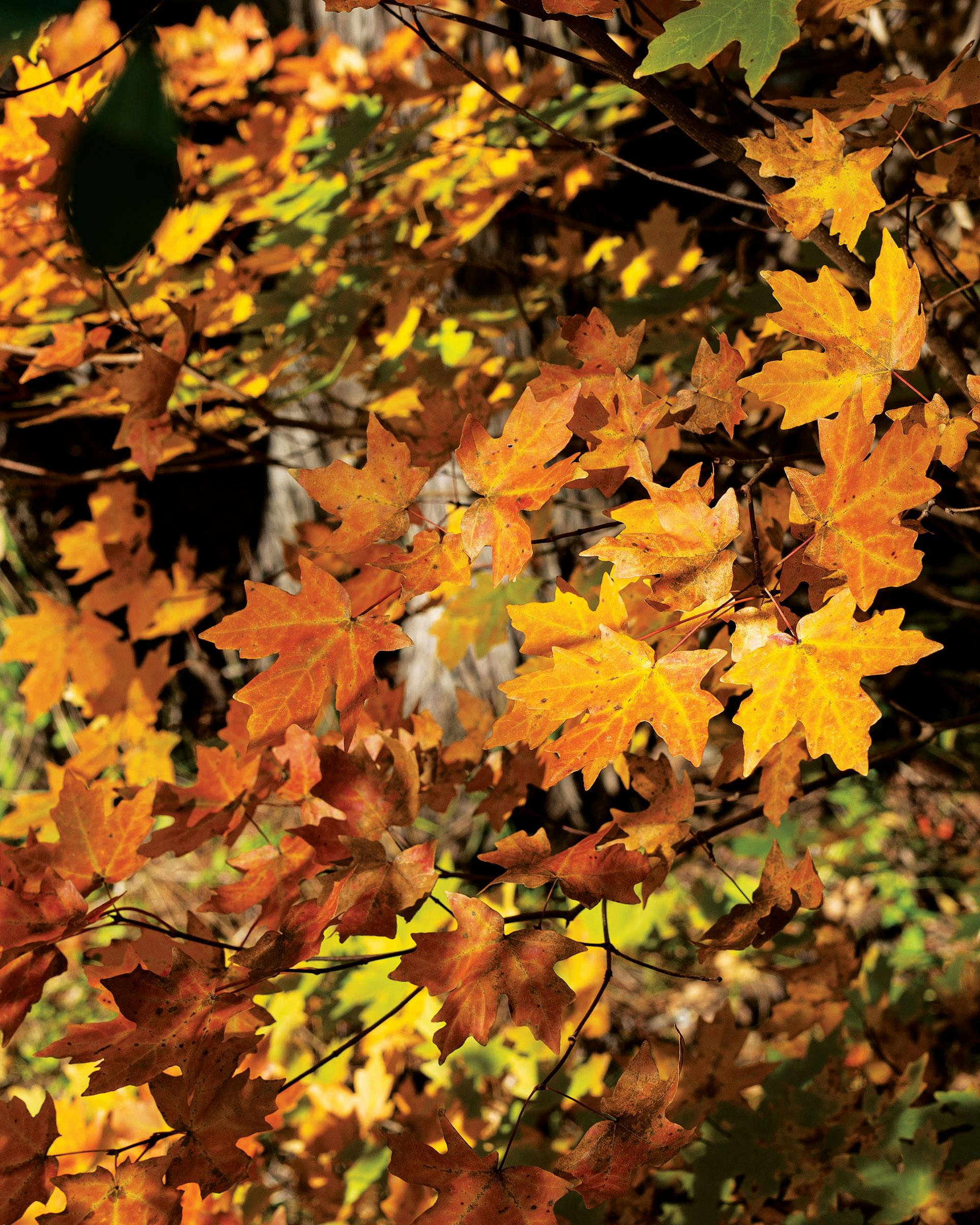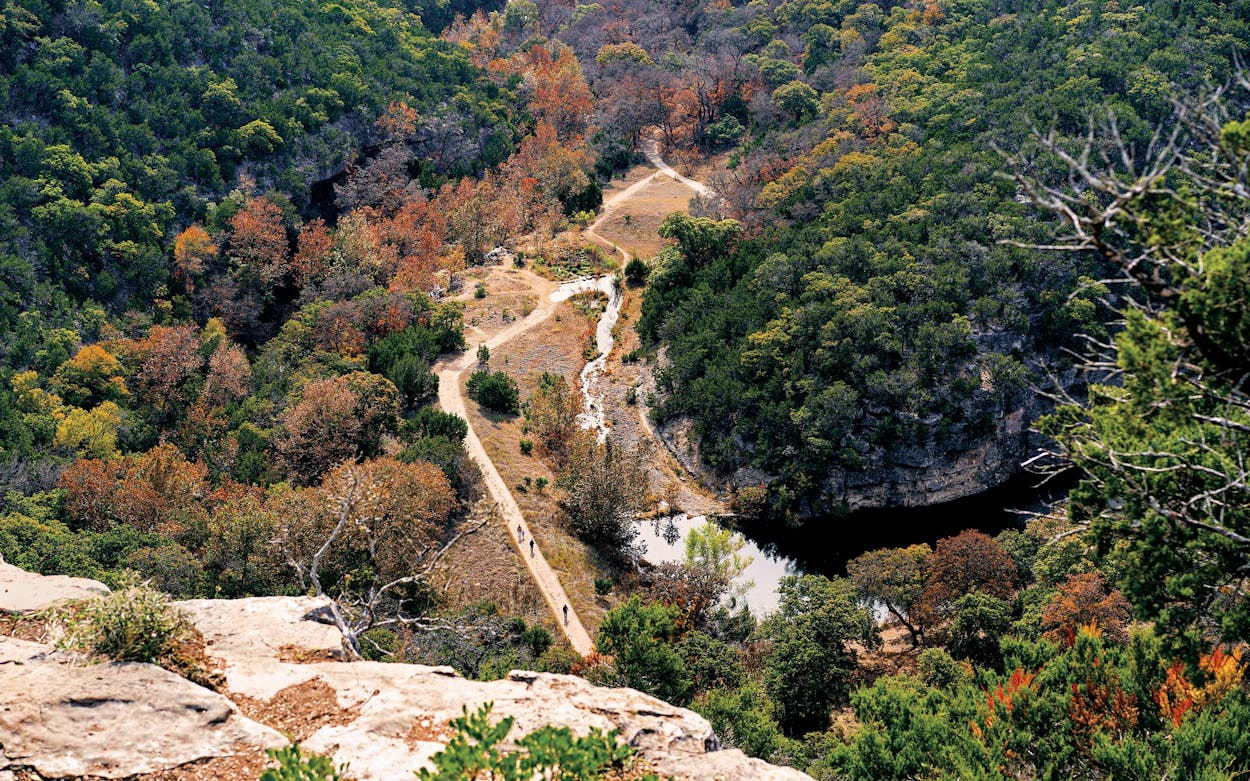How lucky are we?” I can’t count how many times my park pal and I, enchanted by yet another of Texas’s wonderful, wild places, have said that to each other. Alas, this year, this annus horribilis, we have had fewer opportunities to do so, since we, like everyone else, have spent most of our days within the slightly-less-wonderful confines of our respective four walls.
But we were certainly feeling fortunate around this time last year, when we hit the road for Lost Maples State Natural Area, outside of Vanderpool, a little less than two hours northwest of San Antonio. There’s a pleasant surprise around just about every bend of a windy road through the Hill Country, and Emily and I had barely gotten out of Austin before deciding that it would be foolish not to stop at the legendary Devil’s Backbone Tavern, in Fischer. It was two o’clock on a Friday afternoon, and we were welcomed by a grizzled fella who immediately bought us beers, as if he’d been waiting for us to arrive. Then he pulled up a chair in front of the warm neon glow of the jukebox and set to studying its selections like it was the second thing on his to-do list.
For about an hour we nursed our longnecks and listened to the banter of the ranchers, retirees, sages, and philosophers assembled (“every day like clockwork,” said the bartender) round the big table up front, an elderly dog loosely attached to one of them on what looked like a laundry line. A white-haired gentleman walked in and announced that he was more in need of a haircut than a beer, at which point the bartender stepped away from her post, set him down in a chair, draped him in a leopard-print cape, and got to work. And then we made the acquaintance of Kitty, the bar cat, her collar printed in skulls and crossbones, who emerged from her bed at the end of a long bar top worn smooth by decades of forearms, crawled onto my lap, gently placed a paw on Emily’s chest, and fouled the air with a silent but deadly emission. How lucky were we.

What a delightfully fortuitous start to our exploration of a natural wonder that owes its existence to serendipity. Or at least to a fateful convergence of environmental factors. The famed bigtooth maples (Acer grandidentatum) that have managed to thrive in this little pocket of Central Texas (they grow in only two other regions of the state: the Lampasas Cut Plain and a small sliver of the Trans-Pecos) are often referred to as “lost” (hence the name of the natural area) or “left behind.” There’s a wistful quality to that metaphorical taxonomy, in the idea that the trees have somehow been involuntarily separated from their brethren by outside forces. It would seem more like this little cluster of deciduous diehards benefited from the good fortune of being in the right place at the right time.
Believed to have once been widespread in the area, the trees began to dwindle sometime after the end of the last glacial period, which coincided with the end of the Pleistocene epoch, about 11,700 years ago. The increasingly hot and dry weather was too much for all but the maples that had sprouted up within the sheltering canyons of the Balcones Escarpment. Their descendants put down roots in the fertile soil of the Sabinal River floodplain, basked in the shade of the limestone walls, and drew water from the perennial underground springs. Over time, these lucky survivors adapted to the warmer climate, and once a year, against an evergreen backdrop, they don costumes of chile pepper red, pumpkin orange, sangria burgundy, and split pea green and proceed to put on a show that runs for about one to two weeks in November, year after year.
That spectacular spectacle makes Lost Maples a crowd favorite right up there with Garner and Palo Duro Canyon state parks. The state natural area (which differs from a state park in that caretaking efforts are geared more toward keeping the place wild than toward providing amenities for visitors) draws around 200,000 visitors a year, almost half of those within a six-week period in the fall. Camping reservations or day passes are essential, even when there isn’t a pandemic. Upon entering Lost Maples, we were met with a clearly exasperated gatekeeper, weary from hours spent turning away carload after carload of people who had hoped to lay eyes on the rare display of fall foliage (including a couple who she said—surely we misheard—“drove from Israel”). “Texans love them some peepin’ leaves,” said Emily, shaking her head in wonder.

Bass Masters
Within Lost Maples, the Sabinal River is a sanctuary for the rare Guadalupe bass, the male of which is a paragon of paternal protection, carving out a nest in the gravel for the female and guarding it till her eggs hatch and the fry swim away.
No doubt this brief, collective bout of dendrolatry reflects our longing for the kind of cozy fall enjoyed in other states. (When “four seasons” and “Texas” are used in the same sentence, the speaker is often referring to top-notch room service and very comfortable beds.) It seems that overnight our state trades hellish heat for bone-
chilling cold of the protect-your-pets-pipes-plants variety. To everything there is a season, except Texas. But for a fleeting moment, around the first of November, if wind and weather permit (sunny days, cool nights, the right amount of rain), Lost Maples can put on a New England–style display.
Besides marveling at majestic trees, visitors can camp, hike, fish, and birdwatch, and it’s a beautiful place to do all of it, regardless of the time of year. Sabinal Canyon and its namesake waterway, which has its headwaters in Lost Maples, was christened the Arroyo de la Soledad—Stream of Solitude—by early Spanish explorers; “Sabinal” comes from the Spanish sabino (“cypress”). Solitude may be hard to come by in prime leaf season, but with 10.5 miles of trails in a little more than 2,000 acres, it’s easy to find a bit of wilderness on a long walk through Lost Maples’ various landscapes, which range from riparian woodlands to grassy plateaus.
In one slowly ascending trek you can gaze at a maple wearing a coat of many colors and later stumble across a somewhat rare tobusch fishhook cactus (because regular spines aren’t enough, apparently). Flaming red oaks dot the bluffs, and yellow-brown sycamore leaves join with maple to carpet the trails like crinkly, crackly paper stars. The opportunity to traverse the shallow, clear Sabinal presents itself here and there, as the river struggles along, above-ground and below, to meet its appointment with the Frio River, sixtyish miles to the south.
And though the flamboyant trees take center stage, a quick detour off the East Trail to Monkey Rock is a must. A delightful rock outcropping rising out of a moss-colored trickle of the Sabinal, it looks exactly like the head of a monkey, its pert ears and wide-open mouth suggesting that it has been waiting forever for someone to talk to. Farther along is the enchanting Grotto, where centuries of gently seeping calcite-rich water have created a multilayered travertine wall, a craggy, pockmarked face to which maidenhair ferns cling like little green beards. Higher elevations allow for scenic overlooks of the valley, a scrubby-green canvas punctuated by bursts of yellow and orange, and Can Creek, a stream best explored from points along the rugged and steep West Trail, where the clear water melodically tumbles over the rocky terrain before it stops to rest in an inviting emerald pool (unofficially called the Pond) and then continues to poke along on its way to the Sabinal.

At the tail end of our own West Trail hike, as we headed toward our lovely little campground ringed by rolling hills, we were overtaken by a herd of Boy Scouts for whom the magic of this unusual place had been temporarily lost: “The faster we walk, the faster we get to eat, gamers!” We later caught up to the group, clustered around picnic tables at the Pond, and discovered that the struggle was real and ongoing: “That’s not how you cook ramen!” yelled one of them, while a couple others amused themselves skipping stones across the glassy water. All of which left us feeling charmed and warm and fuzzy, all the way through setting up our tent and somehow building a fire. The good vibes continued as we feasted on wine and cheese and marveled at the stars (Lost Maples rates a three out of nine on the Bortle Dark-Sky Scale; for comparison, Big Bend Ranch State Park rates a one, the darkest level).
But then, deep in the night, as the temperature dropped to about 40 degrees, we experienced our own private ice age, one that our “Sundome” tent, layer upon layer of clothing, and, in my case, hastily acquired $16 sleeping bag (my good one left at home, resting snugly on a shelf) could not withstand. I can only surmise it was hypothermia-induced delirium that allowed Patsy Montana’s “I Want to Be a Cowboy’s Sweetheart” to play over and over in my head as I lay frozen in the fetal position, the incessant “oh-duh-lay-hee-hees” an infernal soundtrack to existential musings like “How did cowboys sleep outside?” and “Did they even drive cattle in the winter?”
Meanwhile, Emily, in an unfortunate twist of fate, had to leave our flimsy shelter at around four in the morning to visit the restroom; the horror of the experience was somewhat allayed by the fact that the building had warm hand dryers. (She lingered long enough for me to consider that something might have happened to her, debate whether to go looking for her, and finally decide to let nature take its course.)
Thankfully, she returned, none the wiser, and we lay there waiting for rosy-fingered dawn, at which point we bounded out of the tent and dismantled our site in less than five minutes. Peeling out of the parking lot, we paused only to admire the gentle fog draping the hilltops and to take photographs of a particularly red maple and a remarkably orange one, standing tall, resplendent in their glorious colors, and looking perfectly, happily at home.
- More About:
- Parks & Recs









